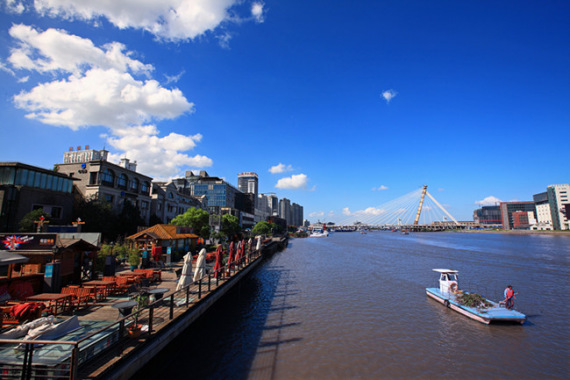10 sensuous delights of a visit to Ningbo
 0 Comment(s)
0 Comment(s) Print
Print E-mail Shanghai Daily, May 25, 2015
E-mail Shanghai Daily, May 25, 2015
Ningbo surprises with an interesting mix of modern city life, traditional towns and a chance to get back to nature in vast parks or at Dongqian Lake.
1. Old Bund
Ningbo's dominant role as one of China's oldest international trade centers is represented by the city's "Old Bund." It was first established in 1844 after the First Opium War (1840-42) and preceded by two decades the more famous Shanghai Bund.
The Old Bund is now a bustling area of pubs and other entertainment.
It is located at the convergence of three waterways in Ningbo, which once served as a major port area for the city. Foreign powers took over the area and transformed it into a foreign concession, with buildings constructed in the Western style to accommodate overseas residents. One of the most charismatic structures still remaining is a French Catholic church built in 1872.
The Old Bund underscores the emergence of Western civilization in China. It is also the only place in Zhejiang Province that still reflects traditional port culture.
Ningbo has long been a city of commerce. Some 31 of the 54 traditional buildings in the city's commercial zone have close connections with local business clans. From here, Chinese merchant ships plied the seven seas.
After its heyday in the 1920s and 30s, the Old Bund fell into disrepair. In 2005, after intensive rehabilitation, the 80,000-square-meter area became a popular entertainment zone, with hotels, shopping and a sparkling nightlife.
2. Tianyige
Tianyige Library, the largest private library in China, got its name from "I Ching," or the "Book of Changes." According to this classic book of yin and yang, which may date back to the second millennium BC, a combination of "tian" (sky) and "yi" (one) gives birth to water.
This magical name has protected the library and its books from fire for more than 400 years.
Before the trip, I'd heard a lot about Tianyige, such as it's the oldest private library in China and has more than 300,000 historical books.
However, the building itself was quite different from what I'd imagined — a modest two-story wooden structure.
From its appearance, it could be taken for an ordinary residence of a big family.
The library pavilion was built in 1561 as a private study for Fan Qin, who served as secretary of defense during Emperor Jiajing's reign in the Ming Dynasty (1368-1644). It was not uncommon for ancient Chinese scholars to possess private libraries. Books were a sign of wealth and cultural status, and Fan was an avid collector.
The Fan family adopted a discipline that no one in the family was allowed to claim any of the books as personal property, and books were prohibited from being taken out of the pavilion. The collection today is the most extensive accumulation of information on the education, economic development, literary and revolutionary history of Ningbo.
Tianyige Museum, which includes the library, a living area and the garden of the Fan family, covers over 31,000 square meters. Some of the rooms have been transformed into exhibition halls, where ancient Chinese manuscripts are available for public viewing. The garden itself is worth a visit. Its traditional style provides tranquil solace for all who walk there.
The modern museum is now home to around 300,000 volumes — and rising. With high-tech temperature and humidity control equipment and huge modern shelves, these historic books are finally safe.
One third of the books are already digitalized so book lovers can flip through the yellowed pages on the museum's website without touching the actual volume.







